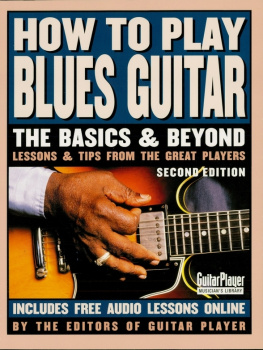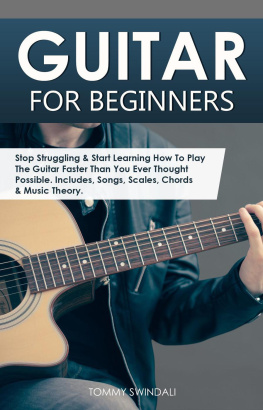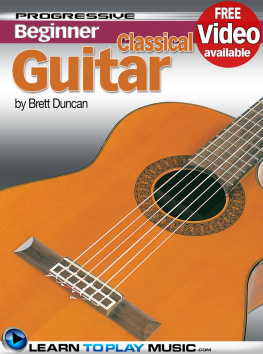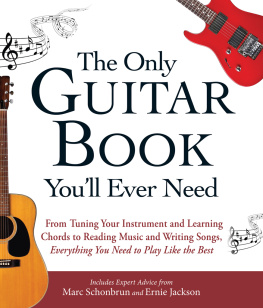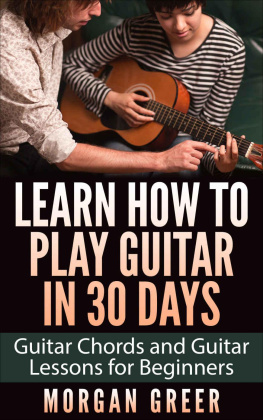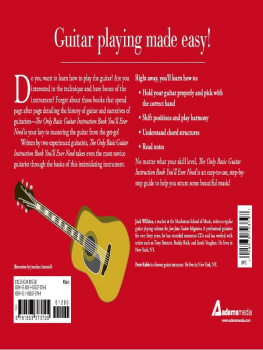Dedication
This book is dedicated to the late Doctor of Music
John Swain: PHD
John Swain was a department head at CSULA which is where I met Bob Fetherolf. Before any time at all, Bob and I were gigging together and collaborating. As a senior music teacher in AUSD, as well as a professional touring musician, I assisted Bob in his teaching pursuits as well, and John Swain guided us both through our graduate music programs. He was a great teacher and a wonderful human being and we both miss him. He was the first editor and collaborator on Bobs excellent guitar manual that you have before you now. This is because the first edition of the book was Bobs Masters Degree Thesis! Now we have, several years and editions later, the final product and a fine product it is. This guitar book is useful for teachers as well as students in classrooms, studios, and homes. It covers not only guitar basics, but note reading, music theory and the ever helpful modern guitar tablature that sometimes accelerates learning of difficult passages unique to guitar.
Good Luck, Sincerely, Dave Batti
INTRODUCTION
Bob Fetherolfs Learning to Play the Guitar is a comprehensive approach to learning the guitar which provides for the development of a variety of styles. It begins with the basics and then moves into more intermediate and advanced levels. This method will provide the means to capture and maintain the students interest, and get them playing music on the guitar before they can become bored and possibly lose interest due to the over-use of technical or repetitive exercises. Included in this method will be note reading and music theory, instrumental solos and ensemble works, finger-picking and flat-picking, strumming exercises, and writing and improvising techniques. The assumption is made that the student has had no previous experience with the guitar or any other musical instruction. For those students who have had some level of exposure to the study of music, they may benefit from the review of familiar material. This method can be used successfully for classroom, private and or self-instruction scenarios, but it should be understood that having access to a teacher is always an advantage.
For the student it is important to remember that the guitar has a long and honorable history. The ability to play a few chords does not come close to realizing the guitars full potential, but it can get you into playing music right away. Yet properly studied, with patience and consistency, the guitar can open the door to a new and exciting world of music. A consideration for classroom teachers utilizing this material is that, if possible, it may be helpful at certain points of instruction to break the class into smaller groups based on their experience and ability.
Part one explains the parts of the guitar, as well as how to hold and tune the guitar. One should strive to be familiar with all the terminology as it relates to the instrument. One should also check their positions occasionally and make corrections as needed. Work to develop an ability to differentiate between levels of pitch in order to play in tune. As well, check the intonation of the guitar and make sure the neck is straight.
There are chord diagrams included primarily in part two and the first chords to be studied will be open string chords followed by bar chords. Apply these chords to the songs in the song sections and most importantly, to outside songs of your preference, using the suggested strums and accompaniment patterns. To play songs in more difficult keys, you must learn bar chords. Remember that although your fingers may become sore in the beginning, they will toughen up and increase in flexibility and dexterity as you increase in your studies.
Guitar History
Although the exact origin of the guitar is still unknown, it is widely known that, in one form or another, it was popular in ancient times in Persia, many Middle Eastern countries, and in Rome. It is quite possible that the guitar evolved from the lute after the lute had been brought to Spain during the Moorish invasion of 711, but whether introduced by the Moors or the Romans, it eventually became the prominent feature of musical life in Spain. It is certain that the instrument existed in Spanish surroundings since the thirteenth century in at least two varieties: guitarra latino and vihuela. Most of the early great guitarists were Spanish and Italian, and they were also very popular in other countries as well where they often toured, popularized and revitalized local interest in the guitar. Fernando Sor, (born in Barcelona, 1778, died in Paris, 1839) one of the greatest performers and composers of the guitar, is an excellent example of a touring guitarist who extended the influence and popularity of the classical guitar.
Interest in the guitar varied from country to country during the Baroque and pre-Classic eras. The guitar was popular in France at the time of Louis XIV and the King was an enthusiastic player, as was Charles II of England. Yet during the high Baroque era there was often a lingering preference for the temperamental, now somewhat ill fated Lute; a preference that seemed to be shared by such notable composers of the era as Sylvius Leopold Weiss and Johann Sebastian Bach. The delicate tonal properties of the Lute made tuning difficulties a constant, which probably added to the late Classic eras redesigned guitars popularity.
Other changes in the guitars construction and stringing took place in the late eighteenth century. Baroque guitars usually consisted of five double courses (ten strings, two for each pitch). Englands guitar in the early part of the eighteenth century, with its five double strings suffered a decline in popular interest, being supplanted by a revival of the ancient cittern: a small wire string instrument sounding somewhat like a mandolin. The cittern became known as the English guitar, which has served to confuse some historians. For instance, when a niece of George Washingtons wrote her uncle begging him for a guitar, the strongest possibility is that she in fact wanted a cittern. These instruments were gradually replaced by the six-string guitar in Italy and France and somewhat later in Germany and Spain.
Single stringing facilitated good intonation and fluent technique and replaced the five doubled courses with six single strings. It reinforced and propelled the emergence of the guitar into the late eighteenth century. Fan strutting and other ways of strengthening the body were also developed which had the added benefit of increased resonance. A larger body, and hence, longer strings, as well as the adoption of a larger, open sound whole were other changes that led, in the early nineteenth century, to the appearance and sound of the guitar that we know today. The instrument of the classic period characteristically had a deeper waist than the Baroque guitar. And the number of frets were increased to as many as eighteen compared to the previous ten. In addition, the preference for the rosewood back and sides appeared, now considered indispensable for the concert guitar.





